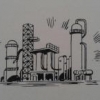Latest Downloads
-
 Water Bath Indirect Heaters
Water Bath Indirect HeatersArt Montemayor - Oct 12 2018 02:35 PM
-
 Petroleum: A Primer for Kansas
Petroleum: A Primer for KansasArt Montemayor - Oct 12 2018 02:27 PM
-
 Spray Tower for Flue Gas Scrubbing Design
Spray Tower for Flue Gas Scrubbing Designankur2061 - May 02 2018 02:31 PM
-
 Selection of Vertical Tanks
Selection of Vertical Tanksankur2061 - Apr 19 2018 07:42 AM
-
 Pressure Drop Calculator for Strainers 1
Pressure Drop Calculator for Strainers 1ankur2061 - Mar 24 2017 02:04 PM
-
 Horizontal Pig Trap System Design Guidelines
Horizontal Pig Trap System Design Guidelinesankur2061 - Jan 14 2017 02:54 PM
-
 Performance Prediction of 3-Stage Propane Refrigeration System
Performance Prediction of 3-Stage Propane Refrigeration Systemankur2061 - Aug 08 2016 02:43 PM
-
 Centrifugal Pump Troubleshooting Checklist
Centrifugal Pump Troubleshooting Checklistankur2061 - Dec 17 2015 08:18 AM
-
 Compressor Troubleshooting Checklist
Compressor Troubleshooting Checklistankur2061 - Sep 08 2015 11:43 AM
-
 Amine Sweetening Unit Preliminary Design
Amine Sweetening Unit Preliminary Designankur2061 - May 19 2015 09:35 AM
Popular Store Titles
 Tank Jacket Calculator
Tank Jacket Calculator
 Specification Sheet Collection
Specification Sheet Collection
 PIPESIZE
PIPESIZE
 Relief Valve Sizing
Relief Valve Sizing
 Rupture Disc Sizing
Rupture Disc Sizing
Chemical and Process Engineering Resources
Submitted Chris Haslego, Nov 21 2011 11:21 AM | Last updated Nov 21 2011 01:29 PM
| Category: | Refining |
| Question: | What are the most common methods of cracking crude streams via a catalyst? |
| Keywords: | cracking,crude,oil,catalytic,catalyst,hydrocracking,methods,streams |
| Answer: | There are two main cracking processes in petroleum refining that use catalyst - catalytic cracking and hydrocracking. Catalytic cracking, uses catalyst and heat to break large hydrocarbon molecules into smaller molecules. The reaction proceeds through carbenium ion formation followed by beta scission of the ion. This forms an olefin and a second carbenium ion. The primary use of catalytic cracking is to produce gasoline (aka petrol) blend stocks from vacuum gas oils and atmospheric resids. Paraffins, Olefins and Naphthene molecules can be cracked, but aromatic rings cannot. Thus, aromatics tend to concentrate in the heavier products. For this reason, the diesel range material produced in the cat cracker is of poor quality. A major by product of catalytic cracking reactions is a solid carbonacious material - coke. This is deposited on the catalyst and burned off in the regenerator. The heat from coke combustion is used to raise the feed oil to reaction temperature and to provide the endothermic heat of cracking. Catalytic cracking is a carbon rejection process. That is, it improves the quality of the feed oils by removing carbon (coke). Most cat crackers use a powdered catalyst that is kept in a fluidized state. These units are refered to as fluid catalytic cracking units or FCCU's. There are still a few moving bed units in operation. These are refered to as TCC's or Houdry units. Hydrocracking uses catalyst and heat to crack hydrocarbon molecules in the presence of hydrogen. The cracking reaction mechanism is similar to that found in fluid catalytic cracking, but both the feed and the products are also subject to hydrogenation reactions. These reactions saturate both the olefins produced by cracking and many of the aromatic molecules found in the feed. Hydrocrackers can produce a wide range of products from LPG to diesel. Because the products are hydrogenated, they contain no olefins and few aromatics. Naphtha from hydrocrackers must be treated further to raise its octane value before it can be used as a gasoline blend stock. The kerosene and diesel range materials, however, are of superior quality. Hydrocrackers are widely used to produce jet fuel and low sulfur diesel. Most hydrocrackers are fixed bed units and the feed is limited to materials boiling below 510 0C. Ebulating bed hydrocrackers (H-Oil, LC-Fining) can process heavier feeds but generally produce somewhat lower quality products. |
Forum Quick Links
Tech Q & A Category List
-
 Bulk Solids
Bulk Solids
-
 ChE Outside the Plant
ChE Outside the Plant
-
 Chemical Process Business
Chemical Process Business
-
 Chemistry Basics
Chemistry Basics
-
 Corrosion
Corrosion
-
 Equipment Design
Equipment Design
-
 Experimentation and Testing
Experimentation and Testing
-
 Fluid Dynamics
Fluid Dynamics
-
 Heat Transfer Technology
Heat Transfer Technology
-
 Industrial Utilities
Industrial Utilities
-
 Mass Transfer
Mass Transfer
-
 Physical Property Information
Physical Property Information
-
 Plant Basics
Plant Basics
-
 Plant Economics
Plant Economics
-
 Preparing to Become an Engineer
Preparing to Become an Engineer
-
 Process Control
Process Control
-
 Reactions and Processes
Reactions and Processes
-
 Refining
Refining
-
 Safety
Safety
-
 Separation Technology
Separation Technology
-
 The Environment
The Environment
-
 Thermodynamics
Thermodynamics

 FB
FB



0 Comments